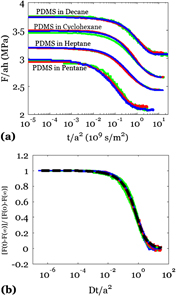Crossref Citations
This article has been cited by the following publications. This list is generated based on data provided by
Crossref.
Hu, Yuhang
Chan, Edwin P.
Vlassak, Joost J.
and
Suo, Zhigang
2011.
Poroelastic relaxation indentation of thin layers of gels.
Journal of Applied Physics,
Vol. 110,
Issue. 8,
p.
086103.
Zhang, Wen-Liang
Qian, Jin
and
Chen, Wei-Qiu
2012.
Indentation of a compressible soft electroactive half-space: Some theoretical aspects.
Acta Mechanica Sinica,
Vol. 28,
Issue. 4,
p.
1133.
Chester, Shawn A.
2012.
A constitutive model for coupled fluid permeation and large viscoelastic deformation in polymeric gels.
Soft Matter,
Vol. 8,
Issue. 31,
p.
8223.
Chan, Edwin P.
Hu, Yuhang
Johnson, Peter M.
Suo, Zhigang
and
Stafford, Christopher M.
2012.
Spherical indentation testing of poroelastic relaxations in thin hydrogel layers.
Soft Matter,
Vol. 8,
Issue. 5,
p.
1492.
Kalcioglu, Z. Ilke
Mahmoodian, Roza
Hu, Yuhang
Suo, Zhigang
and
Van Vliet, Krystyn J.
2012.
From macro- to microscale poroelastic characterization of polymeric hydrogels via indentation.
Soft Matter,
Vol. 8,
Issue. 12,
p.
3393.
Bouklas, Nikolaos
and
Huang, Rui
2012.
Swelling kinetics of polymer gels: comparison of linear and nonlinear theories.
Soft Matter,
Vol. 8,
Issue. 31,
p.
8194.
Hu, Yuhang
You, Jin-Oh
Auguste, Debra T.
Suo, Zhigang
and
Vlassak, Joost J.
2012.
Indentation: A simple, nondestructive method for characterizing the mechanical and transport properties of pH-sensitive hydrogels.
Journal of Materials Research,
Vol. 27,
Issue. 1,
p.
152.
Lucantonio, A.
and
Nardinocchi, P.
2012.
Reduced models of swelling-induced bending of gel bars.
International Journal of Solids and Structures,
Vol. 49,
Issue. 11-12,
p.
1399.
Hu, Yuhang
and
Suo, Zhigang
2012.
Viscoelasticity and poroelasticity in elastomeric gels.
Acta Mechanica Solida Sinica,
Vol. 25,
Issue. 5,
p.
441.
Chan, Edwin P.
Deeyaa, Blessing
Johnson, Peter M.
and
Stafford, Christopher M.
2012.
Poroelastic relaxation of polymer-loaded hydrogels.
Soft Matter,
Vol. 8,
Issue. 31,
p.
8234.
Chan, Edwin P.
Walish, Joseph J.
Urbas, Augustine M.
and
Thomas, Edwin L.
2013.
Mechanochromic Photonic Gels.
Advanced Materials,
Vol. 25,
Issue. 29,
p.
3934.
Liu, Qihan
Robisson, Agathe
Lou, Yucun
and
Suo, Zhigang
2013.
Kinetics of swelling under constraint.
Journal of Applied Physics,
Vol. 114,
Issue. 6,
Li, Meie
Jin, Chao
and
Zhou, Jinxiong
2013.
Finite element implementation of poroelasticity theory for swelling dynamics of hydrogels.
Theoretical and Applied Mechanics Letters,
Vol. 3,
Issue. 5,
p.
054009.
Nurocak, A.
and
Uguz, A. Kerem
2013.
Effect of the direction of the electric field on the interfacial instability between a passive fluid and a viscoelastic polymer.
The European Physical Journal Special Topics,
Vol. 219,
Issue. 1,
p.
99.
Abellan, Marie-Angèle
Zahouani, Hassan
and
Bergheau, Jean-Michel
2013.
Contribution to the Determination of In Vivo Mechanical Characteristics of Human Skin by Indentation Test.
Computational and Mathematical Methods in Medicine,
Vol. 2013,
Issue. ,
p.
1.
Leitner, Loïc
Harscoat–Schiavo, Christelle
and
Vallières, Cécile
2014.
Experimental contribution to the understanding of transport through polydimethylsiloxanenanofiltration membranes: Influence of swelling, compaction and solvent on permeation properties.
Polymer Testing,
Vol. 33,
Issue. ,
p.
88.
An, Zengyong
Xu, Minglong
Feng, Bo
Zhang, Feng
and
He, Xiang
2014.
Novel hybrid piezo-electromagnetic actuator for micro-indentation loading.
Smart Materials and Structures,
Vol. 23,
Issue. 12,
p.
125025.
Zhang, Man-Gong
Cao, Yan-Ping
Li, Guo-Yang
and
Feng, Xi-Qiao
2014.
Pipette aspiration of hyperelastic compliant materials: Theoretical analysis, simulations and experiments.
Journal of the Mechanics and Physics of Solids,
Vol. 68,
Issue. ,
p.
179.
Taffetani, M.
Gottardi, R.
Gastaldi, D.
Raiteri, R.
and
Vena, P.
2014.
Poroelastic response of articular cartilage by nanoindentation creep tests at different characteristic lengths.
Medical Engineering & Physics,
Vol. 36,
Issue. 7,
p.
850.
Chan, Edwin P.
2014.
Deswelling of ultrathin molecular layer-by-layer polyamide water desalination membranes.
Soft Matter,
Vol. 10,
Issue. 17,
p.
2949.



